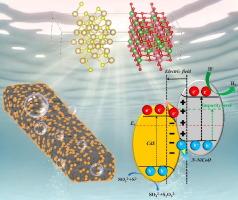Dual-driven charge transport enabled by S-scheme heterojunction and solid solution in CdS@N-NiCoO photocatalysts for enhanced hydrogen evolution
IF 8.1
1区 工程技术
Q1 ENGINEERING, CHEMICAL
引用次数: 0
Abstract
The integration of S-scheme heterojunctions and solid solutions presents a dual-driven strategy for efficient charge transport, thus facilitating superior spatial separation and mobility of photogenerated carriers for overall enhanced photocatalytic behaviors. In this work, the photocatalysts of CdS@N-NiCoO (CdS@NCO) were rationally designed, by combining the ultrafine CdS nanoparticles with N-doped NiCoO (NCO) porous microrods derived from a metal organic framework (MOF) precursor. It is verified that the incorporated N dopants and Co-induced impurities could optimize the electronic structure of solid solution, thereby enhancing the charge separation and mobility of photogenerated carriers. Moreover, according to the UPS and in-situ XPS analyses, the formed S-scheme heterojunction based on n-type CdS ensures the efficient electron-hole separation with improved redox potentials. The resultant photocatalysts achieve an outstanding hydrogen (H2) evolution rate of 4632 μmol·g−1·h−1, which is ∼ 26 times to that of pristine NCO, and outperforms those of most NiO- and Co3O4-based photocatalysts ever reported. Current work might provide some insights on exploring advanced photocatalyst for efficient and sustainable H2 production, enabled by the synergistic effect between heterojunctions and solid solutions.

求助全文
约1分钟内获得全文
求助全文
来源期刊

Separation and Purification Technology
工程技术-工程:化工
CiteScore
14.00
自引率
12.80%
发文量
2347
审稿时长
43 days
期刊介绍:
Separation and Purification Technology is a premier journal committed to sharing innovative methods for separation and purification in chemical and environmental engineering, encompassing both homogeneous solutions and heterogeneous mixtures. Our scope includes the separation and/or purification of liquids, vapors, and gases, as well as carbon capture and separation techniques. However, it's important to note that methods solely intended for analytical purposes are not within the scope of the journal. Additionally, disciplines such as soil science, polymer science, and metallurgy fall outside the purview of Separation and Purification Technology. Join us in advancing the field of separation and purification methods for sustainable solutions in chemical and environmental engineering.
 求助内容:
求助内容: 应助结果提醒方式:
应助结果提醒方式:


